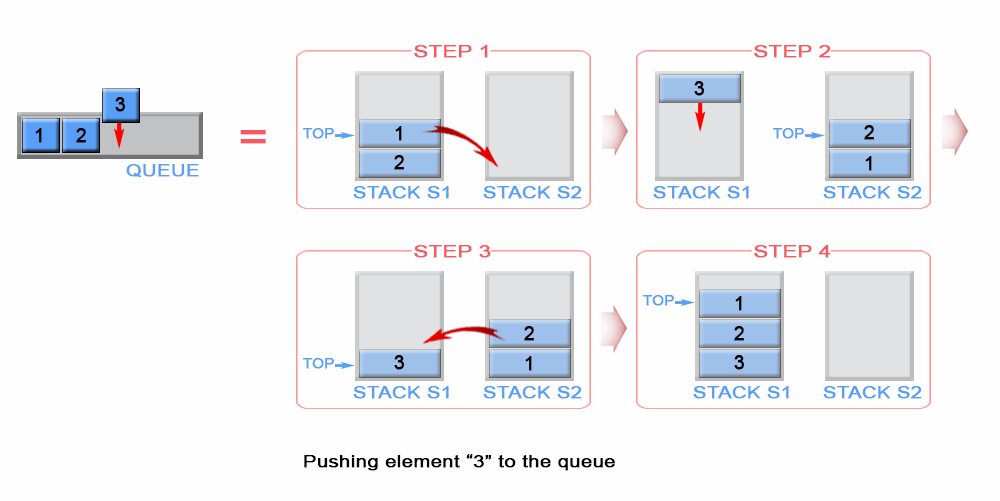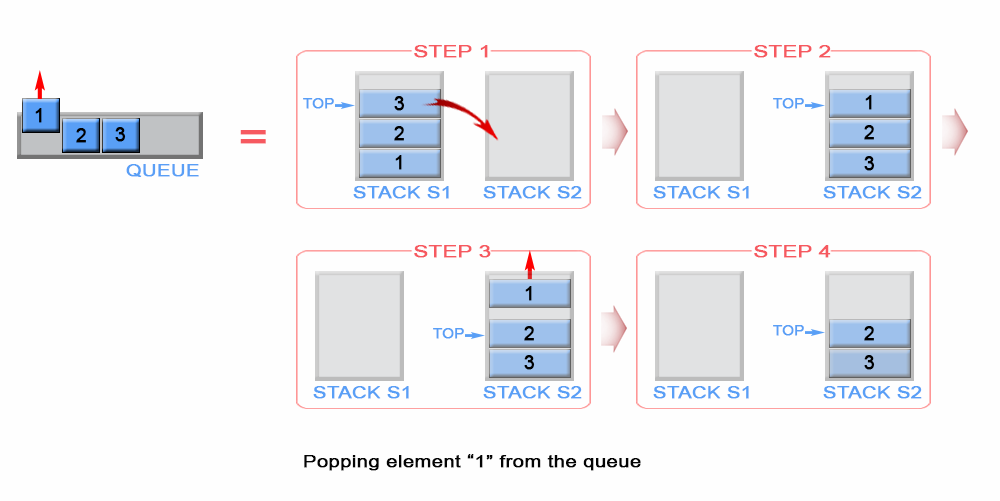Approach #1 (Two Stacks) Push - per operation, Pop - per operation.
Algorithm
Push
A queue is FIFO (first-in-first-out) but a stack is LIFO (last-in-first-out). This means the newest element must be pushed to the bottom of the stack. To do so we first transfer all
s1 elements to auxiliary stack s2. Then the newly arrived element is pushed on top of s2 and all its elements are popped and pushed to s1.
Figure 1. Push an element in queue
Java
private int front; public void push(int x) { if (s1.empty()) front = x; while (!s1.isEmpty()) s2.push(s1.pop()); s2.push(x); while (!s2.isEmpty()) s1.push(s2.pop()); }
Complexity Analysis
- Time complexity : .
Each element, with the exception of the newly arrived, is pushed and popped twice. The last inserted element is popped and pushed once. Therefore this gives operations where is the queue size. The
push and pop operations have time complexity.- Space complexity : . We need additional memory to store the queue elements
Pop
The algorithm pops an element from the stack
s1, because s1 stores always on its top the first inserted element in the queue. The front element of the queue is kept as front.
Figure 2. Pop an element from queue
Java
// Removes the element from the front of queue. public void pop() { s1.pop(); if (!s1.empty()) front = s1.peek(); }
Complexity Analysis
- Time complexity : .
- Space complexity : .
Empty
Stack
s1 contains all stack elements, so the algorithm checks s1 size to return if the queue is empty.// Return whether the queue is empty. public boolean empty() { return s1.isEmpty(); }
Time complexity : .
Space complexity : .
Peek
The
front element is kept in constant memory and is modified when we push or pop an element.// Get the front element. public int peek() { return front; }
Time complexity : . The
front element has been calculated in advance and only returned in peekoperation.
Space complexity : .
Approach #2 (Two Stacks) Push - per operation, Pop - Amortized per operation.
Algorithm
Push
The newly arrived element is always added on top of stack
s1 and the first element is kept as front queue element
Figure 3. Push an element in queue
Java
private Stack<Integer> s1 = new Stack<>(); private Stack<Integer> s2 = new Stack<>(); // Push element x to the back of queue. public void push(int x) { if (s1.empty()) front = x; s1.push(x); }
Complexity Analysis
- Time complexity : .
Аppending an element to a stack is an O(1) operation.
- Space complexity : . We need additional memory to store the queue elements
Pop
We have to remove element in front of the queue. This is the first inserted element in the stack
s1 and it is positioned at the bottom of the stack because of stack's LIFO (last in - first out) policy. To remove the bottom element from s1, we have to pop all elements from s1 and to push them on to an additional stack s2, which helps us to store the elements of s1 in reversed order. This way the bottom element of s1 will be positioned on top of s2 and we can simply pop it from stack s2. Once s2 is empty, the algorithm transfer data from s1 to s2 again.
Figure 4. Pop an element from stack
Java
// Removes the element from in front of queue. public void pop() { if (s2.isEmpty()) { while (!s1.isEmpty()) s2.push(s1.pop()); } s2.pop(); }
Complexity Analysis
- Time complexity: Amortized , Worst-case .
In the worst case scenario when stack
s2 is empty, the algorithm pops elements from stack s1 and pushes elements to s2, where is the queue size. This gives operations, which is . But when stack s2 is not empty the algorithm has time complexity. So what does it mean by Amortized ? Please see the next section on Amortized Analysis for more information.- Space complexity : .
Amortized Analysis
Amortized analysis gives the average performance (over time) of each operation in the worst case. The basic idea is that a worst case operation can alter the state in such a way that the worst case cannot occur again for a long time, thus amortizing its cost.
Consider this example where we start with an empty queue with the following sequence of operations applied:
The worst case time complexity of a single pop operation is . Since we have pop operations, using the worst-case per operation analysis gives us a total of time.
However, in a sequence of operations the worst case does not occur often in each operation - some operations may be cheap, some may be expensive. Therefore, a traditional worst-case per operation analysis can give overly pessimistic bound. For example, in a dynamic array only some inserts take a linear time, though others - a constant time.
In the example above, the number of times pop operation can be called is limited by the number of push operations before it. Although a single pop operation could be expensive, it is expensive only once per
ntimes (queue size), when s2 is empty and there is a need for data transfer between s1 and s2. Hence the total time complexity of the sequence is : n (for push operations) + 2*n (for first pop operation) + n - 1 ( for pop operations) which is .This gives = average time per operation.
Empty
Both stacks
s1 and s2 contain all stack elements, so the algorithm checks s1 and s2 size to return if the queue is empty.// Return whether the queue is empty. public boolean empty() { return s1.isEmpty() && s2.isEmpty(); }
Time complexity : .
Space complexity : .
Peek
The
front element is kept in constant memory and is modified when we push an element. When s2 is not empty, front element is positioned on the top of s2// Get the front element. public int peek() { if (!s2.isEmpty()) { return s2.peek(); } return front; }
Time complexity : .
The
front element was either previously calculated or returned as a top element of stack s2. Therefore complexity is
Space complexity : .


No comments:
Post a Comment